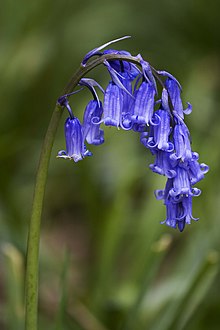
Back صفير غير سكريبتا Arabic صفير غير سكريبتا ARZ Hyacinthoides non-scripta Breton Escil·la atlàntica Catalan Hyacinthoides non-scripta CEB Endymion non-scriptus Corsican Clychau'r gog Welsh Almindelig klokkeskilla Danish Atlantisches Hasenglöckchen German Arbarhiacinto Esperanto
| Hyacinthoides non-scripta | |
|---|---|

| |
| Scientific classification | |
| Kingdom: | Plantae |
| Clade: | Tracheophytes |
| Clade: | Angiosperms |
| Clade: | Monocots |
| Order: | Asparagales |
| Family: | Asparagaceae |
| Subfamily: | Scilloideae |
| Genus: | Hyacinthoides |
| Species: | H. non-scripta
|
| Binomial name | |
| Hyacinthoides non-scripta | |
| Synonyms [1] | |
| |
Hyacinthoides non-scripta /ˌhaɪəsɪnˈθɔɪdiːz nɒnˈskrɪptə/ (formerly Endymion non-scriptus or Scilla non-scripta) is a bulbous perennial plant found in Atlantic areas from the north-western part of the Iberian Peninsula to the British Isles, and also frequently used as a garden plant. It is known in English as the common bluebell or simply bluebell, a name which is used in Scotland to refer to the harebell, Campanula rotundifolia. In spring, H. non-scripta produces a nodding, one-sided inflorescence of 5–12 tubular, sweet-scented violet–blue flowers, with strongly recurved tepals, and 3–6 long, linear, basal leaves.
H. non-scripta is particularly associated with ancient woodland where it may dominate the understorey to produce carpets of violet–blue flowers in "bluebell woods", but also occurs in more open habitats in western regions. It is protected under UK law, and in some other parts of its range. A related species, H. hispanica has also been introduced to Britain and Ireland and hybridises with H. non-scripta to produce intermediates known as H. × massartiana.
© MMXXIII Rich X Search. We shall prevail. All rights reserved. Rich X Search